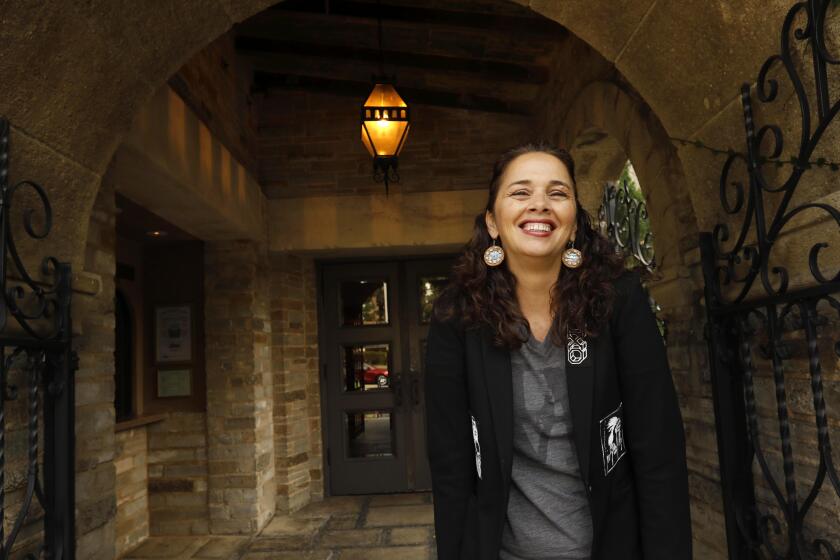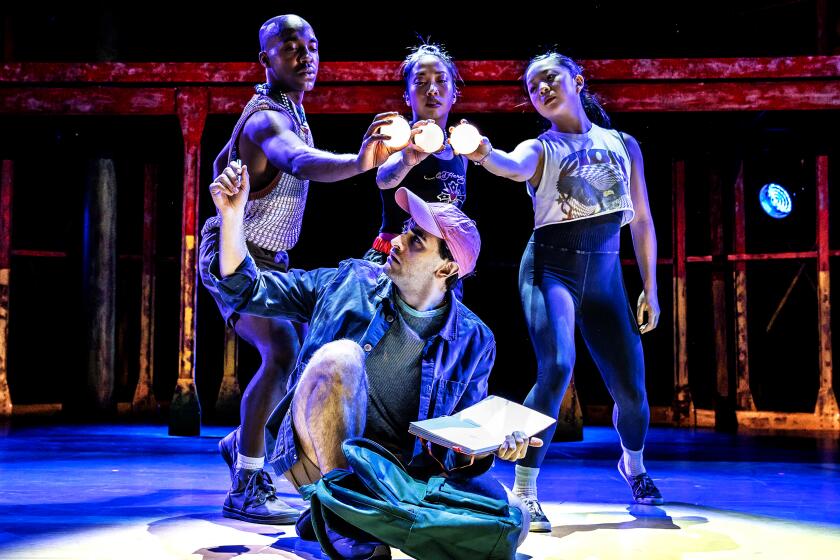The Underground aims to take krump from the street to the stage
In a small Inglewood house near the end of a quiet, dead-end street, Marquisa “Miss Prissy” Gardner and Christopher “Lil’ C” Toler are mock arguing about a bag of Martha’s burritos he’s carrying. “You didn’t bring me any?” she taunts. “Chris-TOE-pher!”
The longtime friends — launched to fame seven years ago by “Rize,” David LaChappelle’s 2005 documentary on South L.A.’s clown and krump dancers — wanted to meet in their childhood neighborhood as they discussed their new joint venture, the Underground, the first-ever concert-dance company to use street-born krump as its choreographic base.
FOR THE RECORD:
Krump dancing: An article in the Feb. 10 Arts & Books section about krump dancing said Jessica Koslow, a producer at the Underground dance company, was a fellow in the USC Annenberg/Getty Arts Journalism program. Koslow earned a master’s in arts at the USC Annenberg Journalism School. It also said that dancer Boogie Frantick is from New York; he is from Los Angeles. And a caption with a photo of Frantick misidentified his pictured dance technique as krumping; Frantick is a popper. —
Toler, 29, skulks to his chair, his red cap pulled low, a chain with three bullets swinging as he moves (“I’m like live ammunition,” he later explains). Vamping like this, Toler evokes one of his film portrayals in “Stomp the Yard” and “StreetDance 2.” But when he sits down next to Gardner, tucking his food aside, he speaks with the same wry, brainy language that’s made him a beloved panelist on “So You Think You Can Dance” (Sample Toler: After a ballroom dancer attempts the chest pops and foot stomps of krump, Toler said: “Swagger is kind of evading him.” )
PHOTOS: Arts & culture by The Times
Gardner, 31, has traded teenage braids for a dyed rooster cut, but otherwise seems the same fearless champion from “Rize.”
Krump dance — though sharing rhythmic origins with clown dancing’s exuberant battles and stripper-style booty-shaking speed — implodes inward with jagged, personalized gestures and seizures of pain and pleasure.
Commercial tastemakers seized on the dance quickly. Since the film Gardner has balanced dance jobs — a tour with Madonna, Pepsi commercials and a recent appearance on “Glee” — with teaching gigs around the globe (most recently Finland and Japan). Also a single mom to Saadiyah, 4, she exudes maternal pragmatism in the playful exchange with Toler. “This is what I’ve dealt with from Christopher since he was 17 years old,” she says. “When I am stressed up to here with dance, C comes to rehearsal like that and it just calms me down.”
In the last six months, these pioneering krumpers have embraced stress. Launched quietly, their company features nine krumpers and street dancers from L.A. and beyond — black and Latino, male and female — with a mixed-bill program of dance for indoor proscenium stages. Conceived by Gardner, with choreographic input from Toler, the richly textured show conveys krump’s origins of “battling” freestyle circles, alongside stirring unison group dances.
Last year the dancers performed at USC and at the Nate Holden Performing Arts Center, and this year they’re booked at Cal State Long Beach in February and at the Nate Holden Street Dance Festival and the Pasadena Dance Festival in April. All this from an all-volunteer troupe without funding, paid management or rehearsal space. Their concerts so far have relied on help from their producing organizations plus small Kickstarter campaigns.
“All I’ve ever wanted is my own dance company,” Gardner says. “Taking the same kids that I danced in the street with all across the world like I’ve been.”
Gardner hopes to incorporate a teaching component into residencies as they start to tour. Feeling the overwhelming hunger for krump from young black girls in Paris and street kids in Rio de Janeiro’s favelas, Gardner says “I don’t feel like krump is just a dance. It’s a culture.”
Toler stresses that this is not just a nostalgic side project for him. “It’s not like I’m attached to [this company],” he says.
“I am a part of the underground. We’re all from here. No one’s an immigrant, no one’s being brought in. People may be from other states, but they’re still from the street.”
To this day, both artists have continued meeting with neighborhood dancers at late-night krump sessions held at rec centers or in parking lots. (“I’m going tonight!” she says.) And it is within these public spaces, with beats blasting from car speakers and dancers egging one another on till 3 a.m., that Gardner has honed her raw, theatrical style while Toler developed a slower, more demonstrative form of krump he calls “subtle bucc.”
“I think the krump style can only evolve if we continue to evolve,” he explains. “That means we have to stay connected and grounded to our art, and we have to stay motivated.”
So a few years ago he asked: “Instead of dispelling your energy at a rapid pace, instead of yelling,” he says, “how about we slow the tempo down and look at dance as a conversation?”
“Now you can tell a story with it,” Gardner says.
It was at one of these street sessions in 2011 that company producer Jessica Koslow, then shooting a film for her master’s thesis for USC’s Annenberg/Getty Arts Journalism program, lighted the fuse for the Underground.
With her own dance and production pedigree (Koslow’s stepfather was the late tapper Gregory Hines, her mother is producer Pamela Koslow of “Jelly’s Last Jam” and “Jane Eyre”), Koslow set off on a mission to help Gardner bring live krumping to a wider audience and defeat what they see as a bias against street dance on the concert stage.
“Street dance is valued commercially,” Koslow says, “but are we looked at as an art form? Why aren’t we at festivals, and why aren’t we touring?”
With faculty endorsement from Sasha Anawalt, director of USC’s arts journalism programs and a longtime dance writer, Koslow applied for a USC Visions and Voices residency grant for Gardner and Toler in September. The result was panel discussions, crammed workshops and the launch of the company to cheering crowds.
Anawalt describes the duo’s telepathic team-teaching (“they really don’t have to talk to each other to understand what the other wants”) and how their codification of krump’s moves convinced her of its lasting potential. “If you can teach it, and you can give it to someone else, then it’s a thing, it’s a technique,” she says.
Gardner’s weaving of other dance styles into the program serves to define krump’s distinct flavor too. On recent bills the group has featured a Chicago foot-worker, “King Charles” Parks, and a New York popper, Boogie Frantick. Another krump founder, Jo’Artis “Mijo” Ratti, sometimes performs.
Area presenters have taken notice of the Underground, appreciating its indigenous L.A. roots and diverse company roster, while acknowledging that the concert needs stronger shaping and higher production values. Gayle Hooks, managing director of Ebony Repertory Theatre at Nate Holden Performing Arts Center, hopes Gardner finds helpful directorial input soon. “That’s going to be the key to them getting ahead and getting ahead quickly,” she says.
Diana Rodriguez, a Center Theatre Group associate producer, hopes to matchmake a collaborator from her theater contacts. “‘Rize’ was David LaChappelle’s version of the krump story,” she says. “This is them telling their own story. I find that eminently more interesting.”
Back on Gardner’s couch, Toler excuses himself. He’s going to finally eat his food and needs to find hot sauce.
“It’s hard to dream something this big when, financially, it just seems like it’s impossible,” Gardner says. “But that’s what we’ve been working with our entire lives.”
-------------------------
The Underground
Long Beach: University Theatre, Cal State Long Beach, near 7th Street and East Campus Road, 4 p.m. Feb. 23. Free. (562)-985-4111
Los Angeles: Street Dance Festival, Nate Holden Performing Arts Center, 4718 W. Washington Blvd., 8 p.m. April 5-6. $15-$25. (323) 964-9766
Pasadena: Pasadena Dance Festival, Civic Auditorium, 300 E. Green St., 8 p.m. April 27. $35-$40. (626) 844-7008
Information: undergroundstreetdance.com
MORE
INTERACTIVE: Christopher Hawthorne’s On the Boulevards
VOTE: What’s the best version of ‘O Holy Night’?
PHOTOS: Arts and culture in pictures
More to Read
The biggest entertainment stories
Get our big stories about Hollywood, film, television, music, arts, culture and more right in your inbox as soon as they publish.
You may occasionally receive promotional content from the Los Angeles Times.






